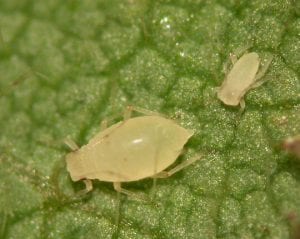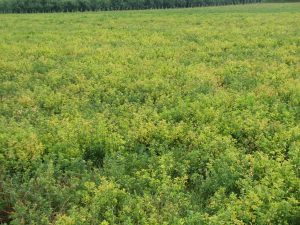Contents
View from the Field
Soybean Aphids
Soybean aphid populations in northern and western NY are high in some areas. The threshold for soybean aphids is 250 aphids per plant from the late vegetative stages to the R5 Stage or under drought conditions the R6 stage. This last week I did see some potato leafhopper nymphs on the leaflets. They do not really cause damage in soybeans but can confused with soybean aphids. Make sure to look closely. Soybean aphids have little tail pipes (cornicles) and potato leafhopper nymphs do not. For more information, please view the following publication or video.
A Visual Guide to Counting Soybean Aphids
Potato Leafhopper
There have been many reports of potato leafhopper (PLH) over the economic threshold in alfalfa fields this last week. The eggs that the adult potato leafhoppers laid have hatched, and nymphs are now in fields. The population will increase with warm to hot weather. If you are over threshold, you have a few options:
- If the field is within 7-10 days of harvest and is over threshold for PLH, it is best to harvest the alfalfa now to maintain the quality of the forage.
- If the alfalfa is not within 7-10 days of harvest and is over threshold for PLH, but does not show the v-shaped yellowing, an insecticide should be applied.
- If alfalfa is short and damage (v-shaped yellowing across the field) has occurred, it is best to clip off the alfalfa and monitor the regrowth for PLH.
It is time to get out and monitor for them.
For more information on thresholds and management, view the following video:
IPM for Potato Leafhopper on Alfalfa
Western Bean Cutworm
This last week pheromone traps for western bean cutworm were placed next to cornfields across the state. We currently have 65 traps monitoring for the flight of western bean cutworm in 28 counties. We will be posting the flight data weekly so you can time your scouting with peak flights across the state. We will also provide a weekly moth flight map that shows where flights are increasing.
Clipboard Checklist
General
*Walk fields to check general field condition, weed issues
*Watch for crop maturity, stand assessments, weed escapes, nutrient deficiencies, lodging issues
Alfalfa:
*Evaluate established legume stands for approximate days until harvest
*Monitor potato leafhopper, foliar, systemic and crown rot diseases.
*Monitor new seedings for potato leafhopper, pythium blight, phytopthora root rot.
Small Grains:
*Monitor small grains for signs of Fusarium Head Blight, foliar diseases
*Monitor grain fields for growth stage, disease issues, grain maturity, harvest timing
*Record diseases present, location and types of weed escapes
Corn:
*Monitor for mid-season corn pests including European corn borer, corn rootworm, western bean cutworm, slugs, foliar diseases such as northern corn leaf blight and gray leaf spot, weed issues, nutrient deficiencies, vertebrate damage.
Soybeans:
*Monitor for crop growth stage, soybean aphid, defoliators, foliar diseases, white mold, weed issues, vertebrate damage
Pastures:
*Check water sources, mend fences as needed.
*Check crop growth, clip pastures between grazing as needed
*Monitor for invasive species, plants harmful to livestock
*Review/Plan rotations
Equipment:
*Carry appropriate / necessary NYS DEC and EPA documents as needed: (pesticide applicators license, pesticide labels, MSDS sheets, etc.)
Storage:
* Check stored grain bins for temperature, moisture and signs of mold and insects. Aerate, core, transfer grain or treat as necessary
* Clean and disinfect empty storage bins in preparation for grain harvest
*Check forage allocation and anticipate feed program adjustments as forages from previous year are used up
*Mow around storage bins and facility to minimize pest hiding places
Dairy Cattle Barn Fly Management:
*Monitor animals and barn area for house fly, stable fly and other pest management needs including presence of rodents and birds.
*Check facilities for favorable fly breeding conditions: (organic matter + moisture): leaks in watering systems, roof gutters for leaks and potential overspill, drainage,
*Sanitation, sanitation, sanitation – clean animal resting areas, feed troughs, minimize source of moist organic matter i.e. fly breeding areas in barn and in adjacent animal loafing yard
* Continue fly monitoring: install “3X5″ index card fly speck monitoring cards throughout barn
*Use, replenish, replace fly management materials: sticky fly tapes/ribbons, insecticide baits, natural enemies (parasitoids), fly population monitoring (3 x 5) spot cards
*Consider purchase and release of Muscidifurax raptor and/or M. raptorellus natural enemies of house and stable fly pupae.
Dairy Cattle on Pasture:
*Monitor animals for presence of face flies, horn flies and stable flies. Action guidelines: face flies (average 10 per animal face), horn flies (average 50 / dairy per animal side, 200 / beef cattle per animal side), stable flies average 10 per animal (all four legs)
*Check feed bunk / water source locations for signs of stable fly breeding (moist undisturbed organic matter – spilled feed, round bales, etc.), minimize source of moist organic matter i.e. fly breeding areas in barn and in adjacent animal exercise yard.
*Check pasture for forage quality / quantity, rotate as appropriate
*Check pasture for vegetation poisonous to livestock
*Consider use of pasture fly traps to help reduce deer, horse and stable fly populations





